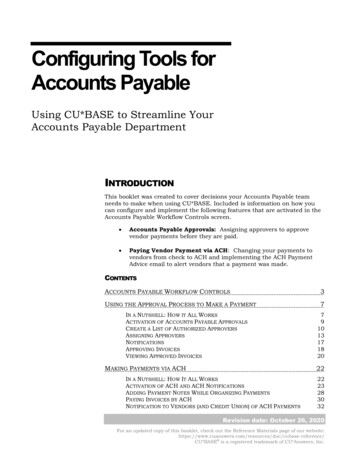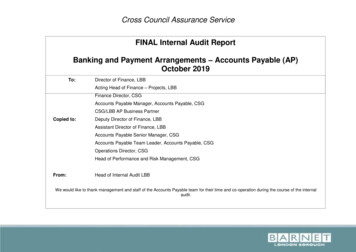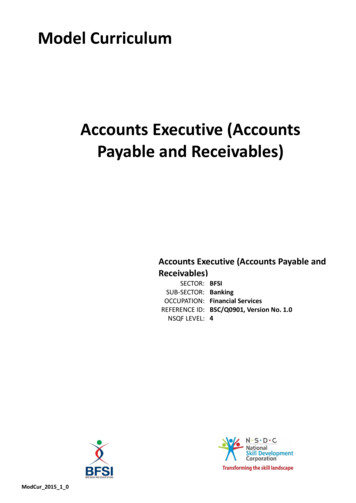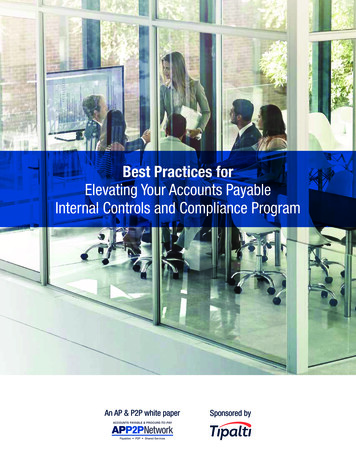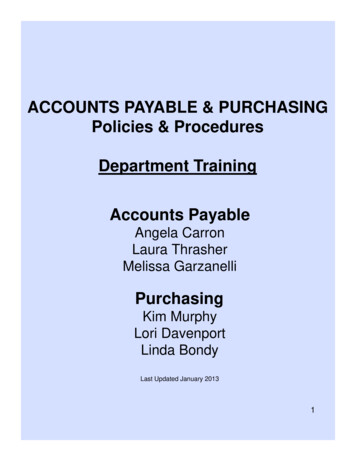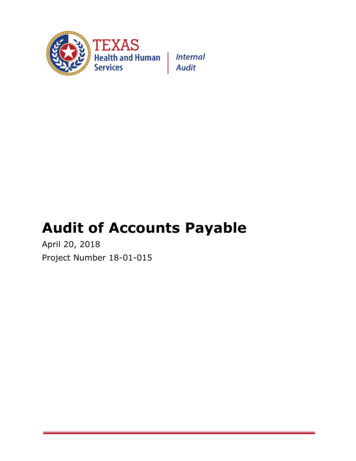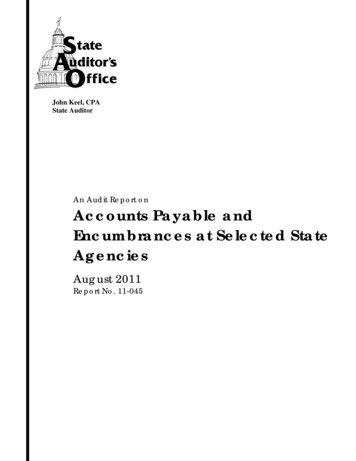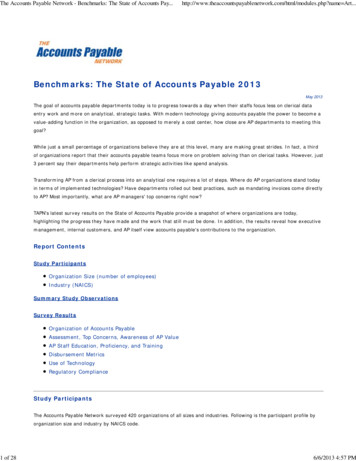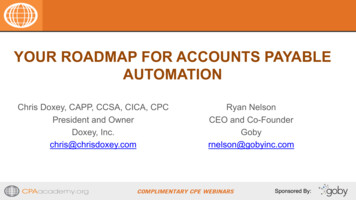
Transcription
YOUR ROADMAP FOR ACCOUNTS PAYABLEAUTOMATIONChris Doxey, CAPP, CCSA, CICA, CPCPresident and OwnerDoxey, Inc.chris@chrisdoxey.comRyan NelsonCEO and Co-FounderGobyrnelson@gobyinc.comSponsored By:
Today’s SpeakersRyan Nelson is the CEO & CoFounder of Goby. Ryan hasmore than 20 years of experiencein enterprise software andleadership positions.As President of Doxey, Inc.and as a managementconsultant, Chris works withher clients to implementinternal controls and processautomation.Chris DoxeyRyan founded Goby in 2009, andsince has been focused onturning big data into bigopportunities, with technology.Ryan Nelson2Sponsored By:
Learning ObjectivesØ Learning Objectives:Ø Define your Business Case for AP Automation.Ø Identify milestones for rapid approval.Ø Obtain an AP Automation Roadmap and the tips for implementation.Ø Learn about the post implementation process and communication process to your stakeholders.Ø Define and measure success.Hint: This webinar is full of templates and checklists that you can use at yourcompany and with your clients!3Sponsored By:
AgendaØ Introduction to AP AutomationØ Your AP Automation Business CaseØ How 10 Top AP Automation Solutions Can Reduce Risk and CostØ Your Roadmap for AP AutomationØ Tips for ImplementationØ Measuring Success with Key AP MetricsØ Q&A4Sponsored By:
Introduction to AP Automation5Sponsored By:
What is AP Automation? AP Automation refers to the technology that is used to streamline and automateaccounts payable processes which includes removing manual tasks and providingbetter visibility and control over important financial data. AP Automation reduces costs with an intelligent acquisition process as every invoiceis automatically captured & coded, and data is extracted from any format.6Sponsored By:
The Foundation of the AP ProcessSupplier Master Controls and Validation Compliance Supplier Data Standards Trade DirectoriesInvoice Process Invoice Automation Accuracy and ValidationPayment Payment Automation Accuracy and Validation Fraud and Risk MitigationSegregation of DutiesCriticalCorporateControlsSystems AccessDelegation of Authority7Sponsored By:
AP and the Procure to Pay (P2P) ProcessSponsored By:8
Your AP Automation Business Case9Sponsored By:
Polling Question 1Within the Procure to Pay (P2P) process, how integrated is yourAP department?a)b)c)d)AP and Procurement report to the same managerAP is a separate departmentAP is a combined function in a Shared Services organizationWe have a P2P transformation underway10Sponsored By:
Your Business Case Template1. EXECUTIVE SUMMARYThis section should provide general information on the issues surrounding the business problem and the proposed project orinitiative created to address it. Hint: Usually, this section is completed last after all other sections of the business case have beenwritten.1.1.IssueThis section should briefly describe the business problemthat the proposed project will address1.2.Anticipated OutcomesThis section should describe the anticipated outcome if theproposed project is implemented.Hint: This section should include how the project will benefitthe AP function and describe what the end state of theproject should be.1.3.RecommendationThis section summarizes how the project will address thebusiness problem. This section should also summarize howthe expected results will be achieved by implementation.1.4.JustificationThis section justifies why the recommended project shouldbe implemented and why it was selected over otheralternatives.Hint: Where applicable, quantitative support should beprovided and the impact of not implementing the projectshould also be stated. Examples: Impacts on AP Cost &Cycle Time, Ability to Capture Data for Metrics and Trends,Continued Risk for processing Duplicate & FraudulentPayments Made.11Sponsored By:
Your Business Case Template (Continued)2. BUSINESS CASE ANALYSIS TEAMThis section describes the roles of the team members who developed the business case. Hint: It is imperative that participantsand roles are clearly defined for the business case as well as throughout the life of the project.RoleDescription (Roles and Responsibilities)Executive SponsorProvide executive support for the projectController/and orController’s StaffProvide financial and risk management analysis and project supportAP Solution ProviderProject Manager Name/TitleProvides all automation and technology support for the projectAdvises team on process improvement techniquesManages the project implementation12Sponsored By:
Your Business Case Template (Continued)3. PROBLEM DEFINITION3.1.Problem StatementThis section describes the business problem that this project was created to address. Hint: Cost, Cycle Time, andPayment Risk.3.2.Organizational ImpactThis section describes how the proposed project will modify or affect the AP process. It should also explain any newroles which would be created or how existing roles may change as a result of the project. (Hint: AP Staff will have morevisibility to data for analytics.3.3.Automation MigrationThis section provides a high-level overview of how the automation will be implemented and how data will be migrated,Hint: This section should also explain any obstacles needed to be addressed.13Sponsored By:
Your Business Case Template (Continued)4. PROJECT OVERVIEWThis section describes high-level information about the project to include a description, goals and objectives, performance criteria,assumptions, constraints, and milestones.4.1.Project DescriptionThis section describes the project approach and expectedoutcome.4.2.Goals and ObjectivesThis section lists the business goals and objectives which aresupported by the project.4.3.Project PerformanceThis section describes the measures that will be used togauge the project’s performance and outcomes as they relateto key resources, processes, or services.Hint: How do we measure success?4.4.Project AssumptionsThis section lists the preliminary assumptions for the proposedproject. As the project is selected and moves into detailed projectplanning, the list of assumptions will most likely grow as the projectplan is developed.4.5.Project ConstraintsThis section lists the preliminary constraints for the proposed project.As the project is selected and moves into detailed project planning,the list of constraints will most likely grow as the project plan isdeveloped.4.6.Major Project MilestonesThis section lists the major project milestones and their targetcompletion dates. Hint: Since this is the business case, thesemilestones and target dates are general and in no way final.(Examples: “As Is” and “To Be” Process Flows Completed,Communication to Suppliers, and User Tests Completed.14Sponsored By:
Your Business Case Template (Continued)4. PROJECT OVERVIEW (CONTINUED)Milestones/DeliverablesTarget DateProject CharterProject Plan Review and CompletionProject KickoffPhase I CompletePhase II CompletePhase III CompletePhase IV CompletePhase V CompleteCloseout/Project CompletionPost Implementation Review (PIR) Complete15Sponsored By:
Your Business Case Template (Continued)6. APPROVALSThe business case is a document with which approval is granted or denied to move forward with the creation of a project.Approver NameTitleSignatureDatePresident or CEOController or CFOProject SponsorProject ManagerFunctional Business Process Owner(AP, P2P or Shared Services)16Sponsored By:
Strategies for Engaging Stakeholders01. Identify KeyStakeholders02. EngageStakeholders Early These will likely include front-lineaccounts payable staff, IT staff,purchasers (those who raisepurchase orders), procurement,financial analysts and treasury. Hint: Your goal is to engagestakeholders who can helpcontribute to the success of theproject. Establish a team of stakeholdersrepresenting different functionalresponsibilities.This team will help you diagnosethe current state of processes,identify areas for improvement,gather business requirements,define the scope of the project,develop business rules forconfiguring the system, makedecisions regarding processchanges, and monitor theprogress of the project.Hint: Limit the team to essentialrepresentatives from each of thekey stakeholders in the project.03. AddressStakeholder Concerns 04. Focus on ChangeManagementNothing good comes of ignoring a‘check engine’ light. The samecan be said about ignoring theconcerns of stakeholders.Be proactive about addressingstakeholder concerns such as howcurrent operational roles willchange, how systems integrationwill be managed, and how thetechnology will be rolled out.Hint: One member of yourstakeholder team should bedesignated to “champion” theproject with constituents acrossthe business and to keep seniorlevel management apprised of anyissue. 17Source: A Complete Guide to AP Automation by GobyTaking short cuts when it comes torolling out a new system can leadto deployment issues and pooradoption.Hint: Be sure to allocate or line upenough resources for IT support,systems administration, testing,training, and “go-live” tasks.Some departments use temporarystaff to free up power users in thelead-up to system deployment tospend more time training theirpeers and testing the system.Sponsored By:
Polling Question 2Should the AP process be automated?a) Yesb) Noc) Not Sure18Sponsored By:
How 10 AP Automation Solutions CanReduce Risk and Cost19Sponsored By:
The State of AP: Where do you stand?STEP 1 The first step in taking stock of whereyou are is to document your accountspayable department’s primaryapproval and exceptions workflows(involve front-line payables staff in thisprocess). Hint: Be sure to capture uniqueworkflows for different types ofinvoices, suppliers and business units. Next, document the challengesresulting from your current workflows. Quantify issues such as Lost invoices and duplicate copies Manual data entry Matching errors and other invoiceexceptions Supplier inquiries and escalations Duplicate payments Late payments and lost discounts(dollar amounts):STEP 3STEP 2 The second step in taking stock ofwhere you stand is to gather baselineoperational data, including: Annual invoice volume Number of full-time equivalents(FTEs) in your department (don’tforget temps!) Average value of compensationand benefits (C&B) per accountspayable FTE total accounts payable cost (FTE *C&B) (any allocations andoverhead) Cost per invoice (Total accountspayable cost / annual invoicevolume) Hint: This information will be essentialfor building a business case forautomation.STEP 4 The third step in taking stock of whereyou stand is to compare your baselineoperational data with industrybenchmarks. Some key benchmarksto focus on include: Cost per invoice Cycle time for purchase orderbased invoices Cycle time for non-purchase orderbased invoices Invoices processed per FTE permonth Rate of duplicate payments Supplier inquiries per 1,000invoices Overall first-pass match rate(invoices to purchase orders) Early-payment discounts capturedas a percentage of spend20Source: A Complete Guide to AP Automation by Goby Based on the review of the currentstate of your accounts payabledepartment, you can begin to createa list of the processes that will betransformed through automation.Consider processes such as: Receiving invoices Extracting data from invoices Matching invoices to purchaseorders Invoice approval workflows Invoice exceptions workflows Supplier account reconciliationand query resolution Reporting and analyticsHint: Be sure to document howprocesses are currently handled, andthe resulting issues. Once you knowwhere you stand, and what you canachieve, it’s time to engagestakeholders.Sponsored By:
The Benefits of AP Automation1.2.3.4.5.Supplier PortalseProcurementeInvoicingPO to Invoice ConversionDocument Management, InvoiceScan and Data Capture6. Automated Matching7. Automated Workflow Approvals8. ePayment9. System Access Verification Tools10.Accounts Payable Self-Audit ToolsImproved APCost,Controls &ComplianceControlsCost21ComplianceSponsored By:
Polling Question 3What AP process should be automated first?a)b)c)d)e)Invoice ProcessingSetting up New SuppliersInvoice PaymentsSelf-AuditsNone of the Above22Sponsored By:
How does AP Automation Impact the Process?1.Supplier Portals: Suppliers can be automatically validated before they are entered intothe supplier master file.– A sound upfront supplier validation process reduces the risk of an employeeattempting to act as a supplier.– Documentation supporting the validation of the supplier is obtained within theonboarding process.2.e Procurement: Requisitions and Purchase Orders are created electronically removingthe risk of errors made in an manual data entry process.– Direct integration with an ERP system supports the three-way matching process andremoves the risk of any clearing account reconciliation issues.3.eInvoicing: Eliminates the risk of processing a duplicate invoice, paying an incorrectamount, or paying the invoice to an incorrect supplier.– Removes possible financial exposure for the company since invoices are paid moreaccurately and in a timely manner.23Sponsored By:
How does Automation Impact the AP Process?(Continued)4.PO to Invoice Conversion: Eliminates the risk of processing a duplicate invoice, paying anincorrect amount, or paying the invoice to an incorrect supplier.– Speeds up the approval time and can improve working capital management since thereare now more opportunities for early payment discount.5.Document Management, Invoice Scan and Data Capture: This automation solutionreduces the risk of fraud and can build in Segregation of Duties (SoD) controls.24Sponsored By:
How does Automation Impact the AP Process?(Continued)6.Automated Matching: Automated matching performs the three-way with no humanintervention reducing the risk of error and improper matches.– Reduces the risk of paying an erroneous or duplicate payment and improves the invoicecycle time process and reduces processing costs by providing data accuracy based onuser defined matching rules.7.Automated Workflow Approvals: An automated workflow can be linked to the employeemaster file in which approval levels are automated updated when an approval moves toanother department and is promoted.– Reduces the risk of fraud since there is no opportunity for manual manipulation.Escalation processes can be built into the workflow to link to the Delegation of Authority(DoA) policy and tables.8.ePayment : This solution reduces risk and enhances controls for the AP process.– The use of ePayment reduces check fraud, check reconciliation issues, and escheatmentprocess challenges.– Besides obtaining significant rebates as more suppliers settle with P-Cards, one of theadvantages to using a P-card is that the buyer is making a deferred payment.25Sponsored By:
How does Automation Impact the AP Process?(Continued)9.System Access Verification: These tools can prevent a fraudulent transaction from beingprocessed within the AP process. As an example, an individual cannot set up a supplier inthe supplier master file, pay that supplier and void the transaction with proper systemaccess controls in place.10. AP Self-Audit Tools: Self-audit tools can often be included in a company’s internal controlprogram as continuous control monitoring (CCM), controls self assessment (CSA) andcontinuous auditing (CA) initiatives.– Duplicate and erroneous payments are prevented before the cash is disbursedimproving the company’s working capital and cash flow position.– Process improvements and improvements to internal control programs as well as theAP process can be made in a real-time environment.26Sponsored By:
Polling Question 4How do you (or your clients) make most of your (their) APpayments?a)b)c)d)Paper checkACHCredit cardWire27Sponsored By:
Your Roadmap for AP Automation28Sponsored By:
Key Components of an AP Automation Initiative The AP transformation philosophy and its application entails:– A strategic vision of future business processes– A proactive rather than reactive approach to technology adoption– A focus on People, Processes and Technology29Sponsored By:
Project Plan for Implementation1. Start small and take it one step at a time: Going digital doesn’t mean you have tocompletely revamp all your financial processes.– Start with a small piece of the pie.– Whether it’s digitizing your paperwork or simply moving to eSignatures, it’s important tounderstand exactly what it is you’re implementing and how it benefits your process. Focuson your biggest “pain point.”2. Ensure you can analyze data to prepare for the future: Before investing in complex dataanalytics, be sure you understand what kind of data you need and how to interpret theinformation.30Sponsored By:
Project Plan for Implementation (Continued)3. Align with corporate priorities and strategy: Tapping into the potential within the businessprocess owner’s organization is key.4. Find or train talent for the implementation of digital and automation technologies:Technology alone isn’t going to help solve all your problems if your team doesn’t understandhow to use it.– Invest in finding or training talent that will be in alignment with your digital strategy to ensureyour team doesn’t get blindsided.5. It takes a village: AP isn’t a lone-wolf operation.– To truly make meaningful changes, you’ll need organizational support. Why is it imperative to go digital? What’s the impact it’ll have on profit margins? How muchwill efficiency be improved?31Sponsored By:
Goby Project GanttChange managementDesignConfiguration & deploymentTestingCommunication and Support (After Contract is Signed)Go Live! Kick-off Meeting: Schedule 1 hour kick off meeting with all stakeholders Biweekly Calls: Biweekly calls will be held during implementation and hyper-care Training Go Live32Hyper-careSponsored By:
Factors for a Successful Implementation1. Rapid Implementation: Every implementation project is initiated by a start-up meeting,where scope, time frame and need of resources are established.2. Resources: Any organization embarking on a transformation needs to be realistic aboutthe resources required.3. Working Together: Internal and frequent communication can make the projectsuccessful.4. Advocates: Management must be vocal advocates for the project. It’s key thateveryone affected by the transformation understands its value.5. Communication and Awareness!33Sponsored By:
Factors for a Successful Implementation(Continued)5. Testing: This is your opportunity to ensure that everything is working as it should. Gothrough all possible use cases and ensure that the system and interfaces work asplanned.6. The Right Mindset: Those who are tasked with managing the implementation shouldapproach the project with objectively, set clear roles and responsibilities for the wholeproject team, work towards goals, deliverables and deadlines.34Sponsored By:
Your AP Transformation Roadmap Putting it all Together35Sponsored By:
Goby’s Training ProgramGoby will provide: Resources to facilitate change management across the organization A customized, role-based training plan A senior solution expert from Goby to lead all education efforts Multiple rounds of individualized training sessions to address the different roles and skill levels throughout andafter implementation Additional training as needed Goby understands that everyone learns differently. A combination of multiple teaching methods will beavailable to all users Refresher sessions and system update training Access to a customized online knowledge center, including instructional video modules and downloadablewhite papers for on-demand education36Sponsored By:
Goby’s Customer FocusSponsored By:
Polling Question 5Do you plan to introduce automation to your AP processes?a)b)c)d)No plansAlready haveYes, within 1-2 yearsYes, 3 years or more38Sponsored By:
Measuring Success with AP Metrics39Sponsored By:
The AP/P2P Automation ScorecardSuppliers and Supplier MasterNumber of Suppliers Using a Supplier PortalNumber of Duplicate SuppliersPercentage of Managed SpendInvoice ProcessingPercentage of Manual ApprovalsPayment ProcessPercentage of Early Payment DiscountsNumber of Suppliers Paid by ACH% of Suppliers Using ACH Electronic RemittanceNumber of Payment IssuesAccounting and Internal ControlsCost per InvoiceNumber of eInvoices PaidAccuracy of AccrualsCycle Time to Process an InvoiceNumber of Financial Closing IssuesInvoices Processed by FTENumber of Self Audits Performed% of Invoices Paid by CheckNumber of Internal Controls IssuesInvoice Match RateReporting, Analytics and Metrics% of Low Value Invoices Paid by CheckP-Card ProcessNumber of Suppliers Paid by P-CardData Accuracy and VisibilityTools for Decision MakingValue of P-Card Rebates40Sponsored By:
Thank You & QuestionsChris Doxey, CAPP, CCSA, CICA, CPCPresident and Owner, Doxey, Inc.chris@chrisdoxey.comRyan NelsonCEO and Co-Founder of Gobyrnelson@gobyinc.com41Sponsored By:
and benefits (C&B) per accounts payable FTE total accounts payable cost (FTE * C&B) (any allocations and overhead) Cost per invoice (Total accounts payable cost / annual invoice volume) Hint: This information will be essential for building a business case for automation. The third step in taking stock of where
